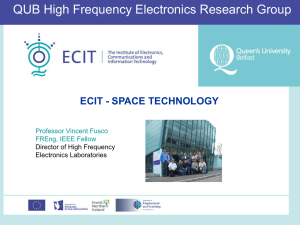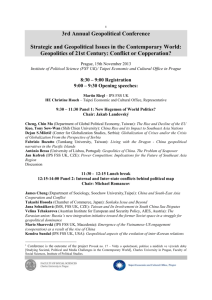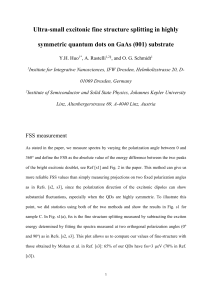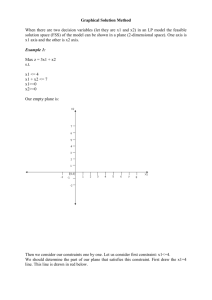3 Fixed service deployment impact on FSS
advertisement
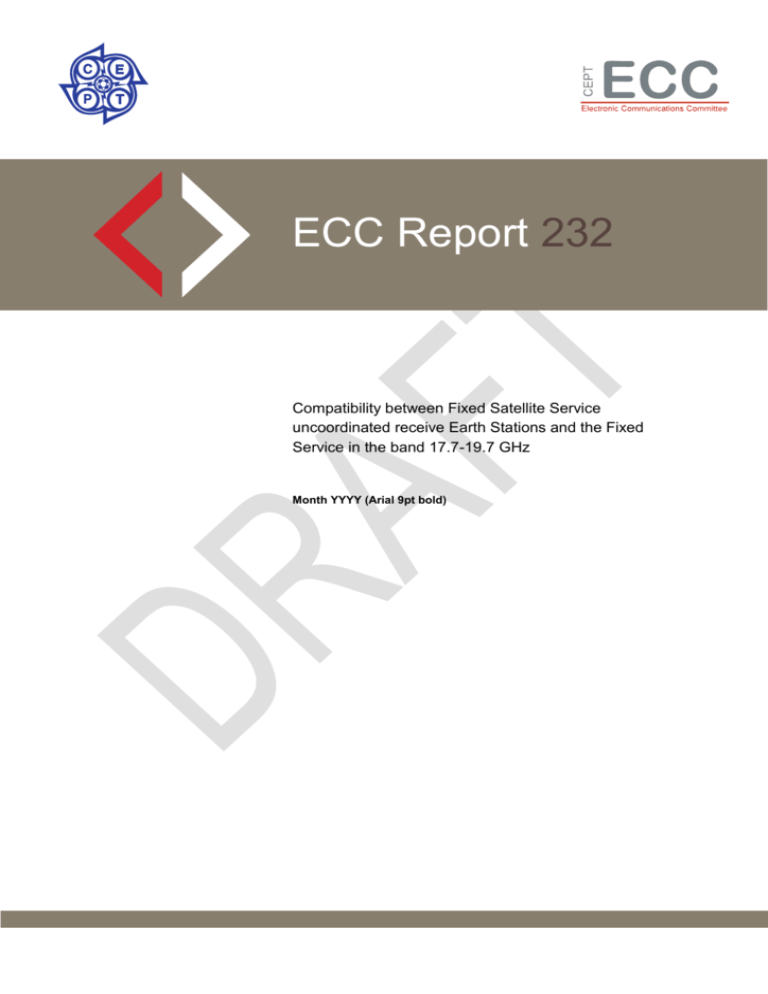
ECC Report 232 Compatibility between Fixed Satellite Service uncoordinated receive Earth Stations and the Fixed Service in the band 17.7-19.7 GHz Month YYYY (Arial 9pt bold) DRAFT ECC REPORT 232- Page 2 0 EXECUTIVE SUMMARY The sharing situation in the band 17.7-19.7 GHz between uncoordinated FSS Earth Stations and Fixed service has been evaluated. FSS uncoordinated earth stations in this band may operate within CEPT on an unprotected basis with respect to the Fixed Service (FS) in accordance with ERC/DEC(00)07 [1]. Given the wide spread and increasing development of the FS (see ECC report 173 [3]: FS in Europe current use and future trends post 2011) in the band 17.7-19.7 GHz, the adjacent band 19.7-20.2 GHz which is allocated exclusively to satellite services, has so far been prioritised by satellite operators and administrations for widespread FSS earth station deployment. However, with the development of high capacity Ka-band satellites systems, and traffic asymmetry that requires more downlink spectrum than uplink, there is a need to examine the conditions under which FSS uncoordinated earth stations would operate under acceptable FS interference conditions in the band 17.7-19.7 GHz. The following issues are covered in this report: Determine the probability that an Earth station in the FSS receives a given level of FS interference in an area where FS is deployed. Estimate the amount of spectrum available for FSS use within the band 17.7-19.7 GHz on a local basis and under a given interference threshold at FSS earth stations. Based on the studies carried out in this report, FSS earth stations deployed in very high FS density zone are able to use more than 65% of the band at the worst location. In rural areas, 95% of the spectrum is available at the worst location for the FSS earth stations. These results are marginally degraded when the simulated FSS earth station is operating at low elevation. Therefore, according to this study, whenever an FSS earth station is interfered by a FS transmitter, there is sufficient available spectrum to reassign the FSS user to non -interfered frequencies. Clutter losses and implementation of ATPC on fixed links would further improve these results. Noting that the main business of the satellite operators is located outside the most dense urban areas and also that the number of FS transmitters is related to the density of the population, the spectrum available today and in the future in those areas should not in principle be higher than the results estimated by this study in very high FS density areas. Therefore compatibility may be ensured in the long term in less populated areas. Technical solutions using flexible frequency assignment to FSS receive earth stations would allow the exploitation of the 17.7-19.7 GHz band by uncoordinated FSS earth stations on a non-protected basis. DRAFT ECC REPORT 232- Page 3 TABLE OF CONTENTS 0 EXECUTIVE SUMMARY ............................................................................................................................ 2 1 INTRODUCTION ......................................................................................................................................... 5 2 SINGLE LINK INTERFERENCE ASSESSMENT ...................................................................................... 6 2.1 Assumptions and methodology ......................................................................................................... 6 2.2 Results for single FS link interference ............................................................................................... 7 3 FIXED SERVICE DEPLOYMENT IMPACT ON FSS ............................................................................... 11 3.1 Methodology .................................................................................................................................... 11 3.1.1 Interference scenario ............................................................................................................. 11 3.1.2 Methodology description ........................................................................................................ 12 3.1.2.1 FS data generation method ................................................................................... 12 3.1.2.2 Interference assessment model ............................................................................ 12 3.1.2.3 Metrics for interference.......................................................................................... 13 3.2 analysis ............................................................................................................................................ 13 3.2.1 Fixed service characteristics ................................................................................................. 13 3.2.2 Satellite system characteristics ............................................................................................. 16 3.2.3 Results ................................................................................................................................... 16 4 IMPACT OF RAIN ON FS INTERFERENCE ........................................................................................... 19 5 CONCLUSIONS ........................................................................................................................................ 20 ANNEX 1: FS INFORMATION IN SOME CEPT COUNTRIES FOR THE BAND 17.7-19.7 GHZ ................. 21 ANNEX 2: LIST OF REFERENCE .................................................................................................................. 29 DRAFT ECC REPORT 232- Page 4 LIST OF ABBREVIATIONS Abbreviation Explanation ATPC CEPT ECC e.i.r.p. ERC ETSI FSS Automatic Transmit Power Control European Conference of Postal and Telecommunications Administrations Electronic Communications Committee effective isotropic radiated power European Radiocommunications Committee European Telecommunications Standards Institute Fixed Satellite Service FS GSO ITU Fixed Service Geosynchronous Orbit International Telecommunication Union DRAFT ECC REPORT 232- Page 5 1 INTRODUCTION This Report addresses the sharing situation in the band 17.7-19.7 GHz between uncoordinated FSS Earth Stations and Fixed service. In effect, FSS uncoordinated earth stations in this band may operate within CEPT on an unprotected basis with respect to the Fixed Service (FS) in accordance with ERC/DEC(00)07 [1]. Given the wide spread and increasing development of the FS (see ECC Report 173 [3] on FS in Europe current use and future trends post 2011) in the band 17.7-19.7 GHz, the adjacent band 19.7-20.2 GHz which is allocated exclusively to satellite services, has so far been privileged by satellite operators and administrations for widespread FSS earth station deployment. However, with the development of high capacity Ka-band satellites systems, and traffic asymmetry that requires more downlink spectrum than uplink, there is a need to examine in detail the conditions under which FSS uncoordinated earth stations would operate under acceptable FS interference conditions in the band 17.7-19.7 GHz. The following issues are covered in this report: Determine the probability that an Earth station in the FSS receives a given level of FS interference in an area where FS is deployed. Estimate the amount of spectrum available for FSS use within the band 17.7-19.7 GHz on a local basis and under a given interference threshold at FSS earth stations. Characterize the FS interference environment as experienced by a FSS Earth station, so that specific areas and/or sub-bands of 17.7-19.7 GHz can be identified as more favourable for FSS use. In order to reach conclusion on the above, the report is structured as follows: Chapter 3 addresses a single FS link interference into a co-frequency FSS receive station, and provides information on distances beyond which interference becomes acceptable, according to various geometrical configurations. Chapter 4 addresses the impact of the deployment of FS over a study area on a FSS system performance: A given FSS earth station may experience interference from Fixed Links located in its vicinity and operating co-frequency. Such Fixed Links operate specific channels of a few MHz to about 100 MHz bandwidth. Therefore, it is expected that a large portion of spectrum could remain locally available. Such availability in particular depends on the density of fixed links, their operating power, the occupied bandwidth of their carriers, their filter characteristics but also on the filter performance of the FSS earth stations. The interference assessment is based on current real Fixed Service deployment information (i.e. assignment database extracts and derived statistics) over areas representative of all types of environments. Such information includes for the considered study areas: location of individual FS transmitters, azimuth, power without use of ATPC, bandwidth, assigned frequency, etc … From these FS input data, and an adequate modelling of the interference path, the interference levels are assessed according to earth station locations. Results are presented in the form of statistics. The methodology is explained in section 3.1 The analysis is in section 3.2 Chapter 5 addresses the impact of atmospheric attenuation, in particular rain. Atmospheric events affect the satellite victim link (that may or may not use rain fade counter-measures), the Fixed Link power level (in case of use of ATPC), and the attenuation on the interfering path between the Fixed station and the receive earth station. All these effects are at least partially correlated. DRAFT ECC REPORT 232- Page 6 2 2.1 SINGLE LINK INTERFERENCE ASSESSMENT ASSUMPTIONS AND METHODOLOGY The interference between FS-stations and user FSS-stations was studied by performing transmission gain simulations for FSS downlink scenario at 18 GHz. The description of the simulation system and path loss model is provided in this section. The terrestrial system is restricted to horizontal point-to-point microwave links with narrow-beam antennas. FSS uplinks are also narrow beam line-of-sight links but have typical elevation angle of 20-50 deg in Europe. The typical trans-horizon link phenomena’s such as ducting and tropospheric scattering can be neglected if only short distances are considered. The precipitation effects due to rain would increase the path loss of interference link, but the approach is to perform the calculations for the worst case interference conditions, i.e. under clear sky. Neglecting the ducting and tropospheric scattering, and modifying the ITU-R P.452 path loss model accordingly, the path loss for such model can be written as L p 92.5 20 log f 20 log d Ld p Ag Ah , where Ld(p) refers to diffraction loss, p refers to probability for path loss not to exceed for p% of time and Ag refers to gaseous absorption attenuation, which consists of attenuation due to dry air and water vapour. A default water vapor density of 3 g/m 3 was used in the calculations. The diffraction loss was taken into account by using a spherical earth model described in ITU-R P.526 [6]. The local clutter provides additional shielding from interference and plays an important role especially over non-trans horizon links. The heightgain model has been applied for the FSS earth station to add shielding loss provided by the clutter. 11 different clutter categories are defined in ITU-R P.452 [5]. The first category, providing least clutter loss, was selected for the path loss calculation. The path loss curves obtained by using the model described above are shown in Figure 1 for 18 GHz. The antenna height for FS-station was set to 40 m and the antenna height of the FSS-station was set to 2 m for all the simulation cases. Path Loss at 18 GHz 250 Free-space loss ITU-R 452 Path Loss [dB] 200 150 100 50 0 5 10 15 20 25 Distance [km] 30 35 Figure 1: Path loss at 18 GHz 40 45 50 DRAFT ECC REPORT 232- Page 7 The path loss increases rapidly after 22-24 km distance. This is the distance where the trans-horizon link parameters start to dominate, and therefore this path loss model is not reliable at longer distances. The trans-horizon link enhancements should have been taken into account if distances larger than 25 km were studied. The distance that is required between an interfering station and the victim receiver strongly depends on the antenna pointing angles between the stations. The median path loss model described above and the antenna patterns from ITU-R F.699 (FS) [7] and ITU-R S.1855 (FSS) [8] are applied in the simulation. Only the off-axis FSS-antenna pattern is defined in ITU-R S.1855 [8], thus the main lobe pattern of FSStransmitter was set according to F.699 [7]. Rotationally symmetric antenna patterns were assumed. The simulation results show the transmission gain as contour levels on a x- y- grid, where the FS-station is placed at x,y = 0,0 and its antenna boresight is assigned to zero azimuth and zero elevation (φ,θ = 0,0). The transmission gains towards all possible locations of FSS-station are calculated. The transmission gain is defined here as the gain from the Tx-antenna input to Rx-antenna output, i.e. the transmission gain is the path loss plus the antenna gains at given location (angle). The FSS-antenna gain towards the FS-station depends on the FSS Earth station location and antenna pointing angle of the FSS earth station, which depends on the satellite azimuth and elevation angles with respect to the coordinate system. The FSantenna gain towards the FSS-station depends on the FSS-station location. Therefore, the simulations have been performed for different satellite elevation and azimuth angles (FSS earth station pointing). 2.2 RESULTS FOR SINGLE FS LINK INTERFERENCE The interference from FS-station transmitter to FSS earth station receiver is studied by simulating the interference link at 18 GHz centre frequency. Several examples of FS-link parameters are listed in ITU-R F.758 [9]. The maximum antenna gains range from 32 to 49 dBi and the antenna gain is at least 45 dBi in most of the cases. Therefore a 45 dBi FS-link antenna pattern was selected for the simulations. The maximum transmission powers at 1 MHz band range from -28 to -9 dBW. The maximum permissible interference power not to exceed 20% of time at the FSS receiver, calculated according to ITU-R SF 1006, is -150.8 dBW/MHz. This is an approximation of the median interference level and is used here to estimate the required transmission loss with median path-loss. This is also well in line with the recently published ITU-R F.758-5, which gives -139 + I/N dBW/MHz as a limit for the nominal long-term interference power for point-to-point FS-receiver in the 17.7 – 19.7 GHz frequency band. Recommendation for the I/N is -10 dB. If -10 dBW transmission power at FS-transmitter is used, the required long-term transmission loss would be 140 dB. The calculated short term interference not to exceed for 0.003% of time is -138.1 dBW/MHz. At 18 GHz, the maximum antenna gain of FSS antenna with 0.6m diameter is 39 dBi. The transmission gain simulation results are shown in Figures 3 – 6 for the FSS earth station antenna pointing towards 15° in elevation and 180°, 150°, 90° and 0° in azimuth. The FS transmitter is located in the centre of the coordinate system (x = 0, y = 0) and the transmission gains to all possible locations of FSS transmitter are calculated. The geometry is based on flat earth approximation, which is valid over short distances; the antenna pointing directions and radiation patterns are applied in the calculation. The distance required to achieve more than 140 dB transmission loss can be evaluated by following the -140 dB gain contour in the figures. The FSS locations outside this contour are possible for FSS operation. These results show that the distance required between the FSS and FS stations is strongly dependent on the FS antenna radiation pattern. At 15 degree elevation, the required distance depends also quite strongly on the FSS antenna azimuth pointing direction, i.e. the satellite azimuth location when the FS-link is located between the FSS station and the satellite. At higher elevations, the FS antenna beam will be pointed well above the FS link, and the interference is filtered out effectively. At 15° elevation, the area where the FSS station cannot operate (inside -145 dB contour), extends roughly up to 2.5 km in y-axis direction (width). The required distance is less than 2 km when the FSS Earth station is located behind the FS station. DRAFT ECC REPORT 232- Page 8 The worst case interference scenario was studied by using free space path loss and setting the FSS antenna azimuth pointing direction towards the FS transmitter in all FSS locations. The worst case simulation result for 15° elevation is shown in Figure 6and for 40° elevation in Figure 7. In this case the required distance to avoid interference is in order of 2 – 5 km when the FSS Earth station is located outside the main beam area of the FS-station. The interference is obviously more severe in the main beam area of the FS-transmitter, where the required distance exceeds 30 km and it cannot be evaluated reliably with the short distance path loss and geometry models applied in this simulation. The earth curvature, tropospheric scattering and radiowave refraction should be taken into account for the trans-horizon links over long distances. Transmission Gain (propagation + antennas) [dB], Satellite Elevation = 15 deg, Satellite Azimuth = 180 deg 5 FS-Antenna Boresight -160 FSS-Antenna Boresight -165 -155 -155 4 -165 3 -150 -155 -150 y, Distance from FS-receiver [km] -160 -150 -145 2 -145 -145 -140 -135 -130 -120 -155 1 -150 -160 0 -145 -140 -135 -130 -135 -130 -120 -120 -120 -130 -135 -140 -1 -140 -120 -120 -130 -135 -130 -135 -165 -140 -140 -145 -155 -2 -150 -145 -145 -160 -165 -3 -150 -150 -155 -4 -170 -160 -5 -5 0 5 -155 10 x, Distance from FS-receiver [km] 15 20 25 Figure 2: Transmission gain contours for FS to FSS link at 15° satellite elevation and 180° satellite azimuth (FSS antenna pointing: 180°, 15°) Transmission Gain (propagation + antennas) [dB], Satellite Elevation = 15 deg, Satellite Azimuth = 150 deg 5 FS-Antenna Boresight -165 FSS-Antenna Boresight -165 4 -160 y, Distance from FS-receiver [km] 3 -165 -160 -160 -155 2 -160 -155 -150 -165 1 -150 -145 -140 -135 -130 -155 -150 -120 -120 -145 -130 -135 -140 0 -1 -120 -120 -130 -135 -140 -140 -135 -130 -145 -120 -130 -135 -140 -145 -145 -145 -2 -150 -145 -140 -135 -130 -160 -150 -150 -155 -155 -3 -150 -165 -4 -155 -170 -5 -5 0 5 10 x, Distance from FS-receiver [km] 15 -160 20 25 Figure 3: Transmission gain contours for FS to FSS link at 15° satellite elevation and 150° satellite azimuth (FSS antenna pointing: 150°, 15°) DRAFT ECC REPORT 232- Page 9 Transmission Gain (propagation + antennas) [dB], Satellite Elevation = 15 deg, Satellite Azimuth = 90 deg 5 FS-Antenna Boresight 4 -165 FSS-Antenna Boresight -165 -165 -160 3 -160 y, Distance from FS-receiver [km] -160 -165 2 -160 -155 -155 -155 -150 -145 -140 -135 -130 -120 1 -155 0 -120 -130 -135 -145 -140 -150 -150 -1 -135 -140 -145 -150 -150 -145 -140 -135 -130 -120 -130 -135 -140 -145 -140 -140-135 -145 -150 -150 -155 -155 -160 -160 -160 -165 -3 -130 -145 -155 -2 -130 -160 -160 -165 -165 -4 -170 -155 -5 -5 -165 0 5 10 x, Distance from FS-receiver [km] 15 20 25 Figure 4: Transmission gain contours for FS to FSS link at 15° satellite elevation and 90° satellite azimuth (FSS antenna pointing: 90°, 15°) Transmission Gain (propagation + antennas) [dB], Satellite Elevation = 15 deg, Satellite Azimuth = 0 deg 5 -165 FS-Antenna Boresight FSS-Antenna Boresight 4 -160 3 y, Distance from FS-receiver [km] -165 -155 2 -160 -155 1 -150 -145 -140 -135 -130 -145 -140 -135 -130 -120 -120 0 -135-130 -140 -155 -145 -1 -150 -150 -160 -155 -2 -165 -3 -160 -4 -165 -5 -5 0 5 10 x, Distance from FS-receiver [km] 15 20 25 Figure 5: Transmission gain contours for FS to FSS link at 15° satellite elevation and 0° satellite azimuth (FSS antenna pointing: 0°, 15°) DRAFT ECC REPORT 232- Page 10 Transmission Gain (propagation + antennas) [dB], Free Space Loss, Satellite Elevation = 15 deg 25 -155 -150 20 -150 15 y, Distance from FS-receiver [km] -145 10 -140 -145 5 -135 -130 -140 -135 -130 -120 0 -120 -120 -130 -5 -135 -140 -155 -10 -145 -150 -15 -20 -150 -25 -30 -20 -10 0 10 20 x, Distance from FS-receiver [km] 30 40 50 60 Figure 6: Worst case transmission gain contours for FS to FSS link at 15° satellite elevation Transmission Gain (propagation + antennas) [dB], Free Space Loss, Satellite Elevation = 40 deg 15 -160 -155 10 -150 y, Distance from FS-receiver [km] -155 5 -145 -150 -140 -135 -130 -120 -145 -140 -135 -130 -120 -160 0 -120 -130 -135 -140 -145 -5 -150 -155 -10 -155 -160 -15 -10 0 10 20 30 x, Distance from FS-receiver [km] 40 50 Figure 7: Worst case transmission gain contours for FS to FSS link at 40° satellite elevation DRAFT ECC REPORT 232- Page 11 3 FIXED SERVICE DEPLOYMENT IMPACT ON FSS 3.1 METHODOLOGY 3.1.1 Interference scenario An FS link may interfere with an FSS earth station located in the vicinity if they operate co-frequency. FS channels Sat. Satellite beam – 500 MHz, 4*120 MHz carriers Figure 8: FS channelling arrangements of ERC/REC 12-03 The above picture shows FS channelling arrangements of ERC/REC 12-03 [2]. This is an illustrative situation where an FS link operates duplex 55 MHz channels (blue and red), and a satellite transmits 4 carriers within a beam of 500 MHz over the area. The FS channels falls within one of the 4 FSS carriers. An FSS receive station operated with that co-frequency carrier within the interference area of the FS link would suffer interference. The capability of the satellite terminal to allocate another satellite carrier among those available would alleviate the interference situation. DRAFT ECC REPORT 232- Page 12 3.1.2 Methodology description The diagram below shows in functional blocks the various elements of the study: Figure 9: Functional blocks diagram taking into account elements of the study 3.1.2.1 FS data generation method Although this would be desirable, it is not possible for various reasons to base the study on an exhaustive database that would describe full FS deployment in the band 17.7-19.7 GHz. It is however necessary to generate a list of transmitters whose characteristics are as representative as possible of the studied scenario. The approach taken is described below: FS transmitter location taken from real deployment data at the scale of a country (e.g. France) or region. The density of such deployment is deemed representative of the situation in most CEPT countries, i.e. it encompasses very low to very high deployment densities. FS Transmission parameters: Maximum power, bandwidth, transmitter height are derived from statistical distributions provided by administrations, and deemed valid within CEPT. It should be noted that some of these parameters may be co-related: e.g. Power with bandwidth, bandwidth with density. No cross compatibility check between the FS channels is affected. Doing so would be complex and is not expected to have a major impact in the results. 3.1.2.2 Interference assessment model For interference assessment, the interference received from all FS transmitter is calculated from all transmitters likely to contribute significantly to the interference, i.e. with frequency overlap. The effects of adjacent band transmitters and FSS receivers overloading are negligible. The propagation model for interference evaluation is P.452 [5]. It is applied in real earth conditions. The value of p% is 0.01%. This percentage of time is very conservative as it is below the unavailability allowance for FSS service. Location of the study area: the elevation of the earth station to the satellite is an influential parameter in the study. Two cases are addressed: satellite at a longitude close to the longitude range of the study area (e.g. 0°E if the study area is France) satellite at a longitude far from the study area (E/S earth stations elevation 10° and above). This is expected to cover the case of high latitudes, where similar elevation conditions exist. DRAFT ECC REPORT 232- Page 13 The algorithm to calculate the interference is described below: where: : Number of FS transmits stations in FSS earth stations visibility. : index of transmit FS stations considered : RF power at the input of antenna of the FS station in dBW/MHz : Off-axis angle between the direction of the FS transmitter and the direction of the FSS earth station (deg) : FS antenna gain of the FS station considered in direction of the FSS earth station (dB) : Off-axis angle between the direction of the FSS earth station and the direction of the FS station (deg) : FSS antenna gain in direction of the considered FS transmitter (dBi) : propagation loss (dB) for p% of the time 3.1.2.3 Metrics for interference The following metrics are derived from the simulation: Probability that an earth station using a given satellite channel is interfered The above probabilities shall be derived for various density areas The number of interference-free satellite channels (statistical and/or mapping) 3.2 3.2.1 ANALYSIS Fixed service characteristics Table 1: FS system parameters Parameter e.i.r.p. Value Comment From e.i.r.p. distribution. See also Note 1 ETSI TR 102 243-1v1.2.1 provides FS operational maximum Tx power levels (equipment capability) Automatic Power Control Range 10 to 20 dB uniform distribution. Remark: Not implemented in the simulation scenario Polarisation Linear FS antenna sidelobe pattern Recommendation ITU-R F.699 [7] FS antenna diameter 75% - 60 cm ATPC functionality is available in most equipment on the market but only few countries impose/use ATPC. Therefore this ATPC range is only relevant for those countries that use ATPC. DRAFT ECC REPORT 232- Page 14 Parameter Value Comment 25% - 30 cm FS transmitter height From distribution Link bandwidth From distribution Channelling ERC/REC 12-03 [2] with link channel random assignment Out-of-band emission mask ETSI EN 302217-2-2 [4] § 4.2.4.2.1 Some administrations have additional band plans which span across the entire band, including the guard bands. Note 1: If FS transmit power is not derived from a distribution, the Tx power can alternatively be derived considering both clear air and rain induced attenuation at 99.99% (typical availability figure), and the system threshold available in ETSI EN 302217-2-2 [4]. It should be noted that higher fixed link availability up to 99.999% can also be assigned. It is noted that the ECC Report 173 [3] provides information for Fixed Service related to the number of links deployed in CEPT countries, the channelling arrangement, and the typical hop length. percentage EIRP cumulative distribution 100 90 80 70 60 50 40 30 20 10 0 France Swiss Greece Germany 0 10 20 30 40 50 EIRP (dBW) Figure 10: Fixed Service transmitters cumulative e.i.r.p. distribution. For France and Greece the distributions are derived from national assignment data. For Germany, the two points shown on the figure correspond respectively to the average and maximum assigned e.i.r.p. in Germany. For Switzerland, the e.i.r.p. statistics are simulated from distributions describing FS receive power, hop length, and antenna size typical for Switzerland. The simulation model has been provided by the Swiss administration. The distributions for the available countries are very consistent. The distribution obtained for France is used for the simulation. Recommendation ITU-R F.758 [9] (Appendix 1 to annex 2) gives an example statistical distribution of FS e.i.r.p. level for one administration. The average e.i.r.p. is 22.8 dBW, with a standard deviation of 4.3 dB. These values are slightly lower, but consistent, with the values shown in the figure above. DRAFT ECC REPORT 232- Page 15 FS transmitter height: The cumulative distribution of FS antenna height for France is taken as a baseline for the simulation: FS transmitter height above ground cumulative distribution Percentage of Tx below given height 100 90 80 70 60 50 40 30 20 10 0 0 20 40 60 80 100 Height (m) Figure 11: Cumulative distribution of FS transmitter height above ground This distribution correlates well with information provided by Switzerland (median height: 27m), and Germany (typical range 10-60 m). Link bandwidth distribution: FS channel width distribution (MHz) 70 60 50 France 40 Greece 30 Switzerland 20 Simulation assumption 10 0 1.75 3.5 7.5 13.75 27.5 55 110 Figure 12: FS link bandwidth distribution The above diagram shows channel width distribution in some countries which made available data. In addition, Germany indicated that 13.75 MHz, 27.5 MHz and 55 MHz channel are used. DRAFT ECC REPORT 232- Page 16 For the purpose of the simulation, a distribution of channel bandwidth of 20% for 13.75 MHz, 56% for 27.5 MHz and 24% for 55 MHz is used. This bandwidth distribution assumption is similar to the one existing in France. 3.2.2 Satellite system characteristics Table 2 provides the technical FSS parameters taken into account in the simulation. Table 2: FSS system parameters Parameter Value Earth station antenna size (diameter) 0.75 m Protection criteria I/N I/N=-10 dB (p=0.01%) GSO satellite orbital position 0° and 65°E (in the simulations respectively 34° and 10° earth stations elevations) 3.2.3 Comment Results The following figure shows the FS transmitters deployment in France. Figure 13: FS transmitters deployment in France The simulations were only run on the highest density area of FS in France (1118 FS transmitters).The FS Transmission parameters (Power, bandwidth, transmitter height) were derived from statistical distributions provided in section 3.2.1. Regarding the FS density, this deployment is deemed representative of the situation in most CEPT countries (high FS density, medium FS density and low FS density). The following Figure 14 provides the simulation areas and also the FS density. DRAFT ECC REPORT 232- Page 17 49.6 18 16 49.4 14 49.2 Latitude in degree 12 49 10 48.8 8 48.6 6 48.4 4 2 48.2 Number of FS per 0.02°x0.02° 1.6 1.8 2 2.2 Area 1 Area 2 2.4 Longitude in degree Area 3 Area 4 2.6 2.8 0 3 Figure 14: Simulation’s areas and FS density. Based on the assumption described above the results are provided in the following tables: Table 3: Simulation results Satellite at the orbital location 0° Number of FS transmitters in the area Minimum spectrum available at the worst location Maximum spectrum available at the best location Average spectrum available in the area Area 1 429 67.33% 100% 85.78% Area 2-1 272 74.56% 100% 93.89% Area 3-2 186 82.54% 100% 97.27% Area 4-3 173 91.52% 100% 98.21% All the study area 1118 67.33% 100% 94.70% Table 4: Simulations results Satellite at the orbital position 65°E Number of FS transmitters in the area Minimum spectrum available at the worst location Maximum spectrum available at the best location Average spectrum available in the area Area 1 429 64.58% 100% 84.87 Area 2-1 272 73.78 100% 91.1% Area 3-2 186 81.54 100% 97.68 Area 4-3 173 93.26 100% 98.95 All the study area 1118 64.58% 100% 96.55% DRAFT ECC REPORT 232- Page 18 In a high density urban area where the FS density is the highest and with high elevation FSS earth station 67.33% of band 17.7-19.7 GHz is available at the worst location for the FSS receiver and in average 85.78% of the band is available in this zone. In an urban area, only 10-20% of the band could be interfered. And in a rural area, more than 95% of the spectrum is available. In case of FSS earth station having a low elevation angle (e.g. 10° and a satellite at the orbital position 65° E), the results are similar. At the worst localisation for the FSS receiver 64.58% of the spectrum is available. The clutter loss due to building attenuation and the polarization were not taken into account in this simulation. It can easily be concluded that considering these additional parameters, the compatibility between FS and FSS may be better and in particular in an urban area. In addition where ATPC on Fixed Links is used the compatibility is improved. DRAFT ECC REPORT 232- Page 19 4 IMPACT OF RAIN ON FS INTERFERENCE Rain rate attenuation can be estimated using ITU-R outage model, which consist of the following: The first step is to obtain the rain rate R exceeded for p% of the time. R values are defined for 15 rain zones (zones C,E,F,G,H,K,L correspond to European zones) and different time percentages, they are defined in the Recommendation ITU-R P.837. Table 5: Rain rate attenuation Percentage of time (%) 1.0 0.3 0.1 0.03 0.01 0.003 0.001 A <0.1 0.8 2 5 8 14 22 B 0.5 2 3 6 12 21 32 C 0.7 2.8 5 9 15 26 42 D E 2.1 0.6 4.5 2.4 8 6 13 12 19 22 29 41 42 70 F 1.7 4.5 8 15 28 54 78 G 3 7 12 20 30 45 65 H 2 4 10 18 32 55 83 J 8 13 20 28 35 45 55 K 15 42 12 23 42 70 100 L M N P Q 2 4 5 12 14 7 11 15 34 49 15 22 35 65 72 33 40 65 105 96 60 63 95 145 115 105 95 140 200 142 150 120 180 250 170 Recommendation ITU-R P.838 [13] using Recommendation ITU-R P.837 [12] computes the specific attenuation (dB/km). The following figure provides the minimum and maximum added attenuation for a given percentage of time due to the rain in Europe. 15 maximum attenuation minimum attenuation Rain attenuation in dB/km 10 5 0 0 0.1 0.2 0.3 0.4 0.5 Percentage of time (%) 0.6 0.7 0.8 0.9 1 Figure 15: Minimum/maximum added attenuation for a given percentage of time due to the rain in Europe Based on the results, it can be concluded that the rain will decrease the interference level of the FS transmitters on the FSS receivers and decrease the I/N value expected at the FSS receiver. DRAFT ECC REPORT 232- Page 20 5 CONCLUSIONS Tables in section 3.2 provide the results of the compatibility studies between FSS earth station receivers and FS transmitters in the band 17.7-19.7 GHz, deployed on a territory on an uncoordinated basis. Based on the studies carried out in this report, FSS earth stations deployed in very high FS density zone are able to use more than 65% of the band at the worst location. In rural areas, 95% of the spectrum is available at the worst location for the FSS earth stations. These results are marginally degraded when the simulated FSS earth station is operating at low elevation. Therefore, according to this study, whenever an FSS earth station is interfered by a FS transmitter, there is sufficient available spectrum to reassign the FSS user to non -interfered frequencies. Clutter losses and implementation of ATPC on fixed links would further improve these results. Noting that the main business of the satellite operators is located outside the most dense urban areas and also that the number of FS transmitters is related to the density of the population, the spectrum available today and in the future in those areas should not in principle be higher than the results estimated by this study in very high FS density areas. Therefore compatibility may be ensured in the long term in less populated areas. Technical solutions using flexible frequency assignment to FSS receive earth stations would allow the exploitation of the 17.7-19.7 GHz band by uncoordinated FSS earth stations on a non-protected basis. DRAFT ECC REPORT 232- Page 21 ANNEX 1: FS INFORMATION IN SOME CEPT COUNTRIES FOR THE BAND 17.7-19.7 GHZ The information provided in this annex has been provided by administrations, and is used in the report to derive representative FS characteristics and deployment data used in the interference evaluation. A1.1 FS INFORMATION FOR FRANCE The following statistical distributions apply for France: FS transmit antenna diameter distribution: % of transmitters per diameter 80.0 70.0 60.0 50.0 40.0 30.0 20.0 10.0 0.0 0.1 0.3 0.6 0.7 0.8 0.9 1 1.2 Figure 16: France FS transmit diameter distribution FS antenna height distribution: Figure 17: France FS antenna height distribution 1.8 >1.8 DRAFT ECC REPORT 232- Page 22 Channel width distribution: Figure 18: France channel width distribution e.i.r.p. distribution: EIRP (France - dBW) 3500 3000 2500 2000 1500 1000 500 0 < -20 -20 -15 -10 -5 0 5 10 15 20 25 30 35 40 45 > 45 Figure 19: France e.i.r.p. distribution Illustrative FS deployment in France in the band 17.7-19.7 GHz as of February 2012: Figure 20: FS deployment in France DRAFT ECC REPORT 232- Page 23 A1.2 FS INFORMATION FOR GERMANY Table 6: Germany FS parameters Parameter max e.i.r.p. e.i.r.p. average min link length Duplex spacing Channel Spacing ATPC (Is Required) Links Modulation Transmitter height above ground FS antenna diameter Value +55 dBW The specific value is laid down when the frequency is allocated +28 dBW 4 km 1010 MHz 13,75 / 27,5 / 55 MHz min range 1 dB 14000 16 – 512 QAM 10-60 m (max 300 m) 30-60 cm Illustrative FS deployment in Germany in the band 17.7-19.7 GHz as of January 2013: Figure 21: FS deployment in Germany DRAFT ECC REPORT 232- Page 24 A1.3 FS INFORMATION FOR GREECE The statistical information in the tables below regarding the fixed service PP links in the 18 GHz band is based on the Greek national frequency registry. Table 7: Greek FS statistical information Unidirectional Unidirectional Links vs Bandwidth Links vs Antenna (MHz) Diameter (m) Unidirectional Links vs Antenna Height above ground (m) Unidirectional Links vs Tx Power (dBm) Unidirectional Links vs EIRP (dBm) 1.75 4 0.3 1196 <10 1764 <15 66 <50 152 3.5 256 0.6 2388 10-20 2050 15-18 1454 50-55 1570 7 3348 0.8 201 20-30 859 18-21 3056 55-60 2202 13.75 830 0.9 20 30-40 251 21-25 550 60-65 1012 27.5 412 1.2 1074 >=40 216 25-30 14 65-70 174 55 290 1.8 261 >=70 30 Total 5140 Total 5140 Total 5140 Total 5140 Total 5140 The following remarks apply: The Greek administration does not impose ATPC use in this band and there is no information about its actual use by FS operators. The antenna height above ground data includes the building height, where applicable. The number of links is unidirectional ones, since a full-duplex PP link consists of two unidirectional links. In Greece, there are no actual unidirectional links in this band, i.e. the half of the total in the excel sheet equals to the number of full-duplex links. In a given full-duplex link, some characteristics (e.g. antenna diameter/height and e.i.r.p.) may differ between Site A and Site B of each link. Each of the two unidirectional links are treated independently in the table. DRAFT ECC REPORT 232- Page 25 The following histograms illustrate the table: Number of links vs Antenna diameter Number of links vs Channel bandwidth 3000 4000 3500 2500 3000 2000 2500 1500 2000 1500 1000 1000 500 500 0 0 1.75 3.5 7 13.75 27.5 0.3 55 0.6 0.8 0.9 1.2 1.8 Number of links vs EIRP (dBW) Number of links vs Antenna Height above ground 2500 2500 2000 2000 1500 1500 1000 1000 500 500 0 0 <20 <10 10-20 20-30 30-40 20-25 >=40 Figure 22: Greek’s FS distribution 25-30 30-35 35-40 >=40 DRAFT ECC REPORT 232- Page 26 A1.4 FS INFORMATION FOR SWITZERLAND Table 8: Switzerland FS parameters distribution Switzerland Parameter Frequency [GHz] Modulation Bandwidth [MHz] FDD separation [MHz] Polarization Altitude above sea level [m] Antenna height above ground [m] Azimuth [°] Elevation [°] Antenna diameter [m] Antenna gain [dBi] Max. Tx power at antenna input (fading) [dBW] Max. Tx e.i.r.p. (fading) [dBW] ATPC dynamics [dB] Nominal Tx e.i.r.p. (clear sky) [dBW] Link length [km] Rx power at antenna output [dBW] Min … Max 17.7 … 19.7 CPM, 4-PSK, 16-/32-/64-/128-QAM 3.5/7.5/13.75/27.5 1 010 Linear 199.0 … 3 294.0 2.0 … 127.0 Median μ ±σ 27.5 1 010 1 010 ±0 -19.3 … +19.3 0.6 … 1.8 37.7 … 48.5 630.0 27.0 0.0 0.0 0.6 39.0 842.4 30.3 Equally distributed 0.0 ±4.2 0.7 40.2 -27.6 … -6.0 -13.5 -14.6 ±4.2 13.1 … 38.6 11.0 … 20.0 1.1 … 23.7 3.3 … 26.1 -92.9 … -75.9 26.4 13.0 11.7 8.4 -85.8 25.6 ±5.0 14.1 ±2.4 11.5 ±4.2 9.0 -85.3 ±3.9 FS transmit antenna diameter distribution: Figure 23: FS transmit antenna diameter distribution DRAFT ECC REPORT 232- Page 27 FS antenna height distribution (above sea level): Figure 24: FS antenna height distribution Link length distribution: Figure 25: Link length distribution DRAFT ECC REPORT 232- Page 28 Illustrative FS deployment in Switzerland in the band 17.7-19.7 GHz as of July 2012: (Bandwidth: Blue: 7.50 MHz; Green: 13.75 MHz; Yellow: 27.5 MHz) Figure 26: FS deployment in Switzerland DRAFT ECC REPORT 232- Page 29 ANNEX 2: LIST OF REFERENCE [1] [2] [3] [4] [5] [6] [7] [8] [9] [10] [11] [12] [13] ERC/DEC(00)07 on shared use of 17.7-19.7 GHz for the Fixed and Fixed Satellite Service; ERC/REC 12-03 on channel arrangements for 17.7-19.7 GHz; ECC Report 173 on Fixed Service in Europe current use and future trends post 2011; ETSI EN 302217-2-2 ‘Fixed Radio Systems; Characteristics and requirements for point-to-point equipment and antennas; Part 2-2: Digital systems operating in frequency bands where frequency coordination is applied; Harmonized EN covering the essential requirements of article 3.2 of the R&TTE Directive’; ITU-R P 452 ‘Prediction procedure for the evaluation of interference between stations on the surface of the Earth at frequencies above about 0.1 GHz’; ITU-R P 526 ‘Propagation by diffraction’; ITU-R F 699 ‘Reference radiation patterns for fixed wireless system antennas for use in coordination studies and interference assessment in the frequency range from 100 MHz to about 70 GHz’; ITU-R S 1855 ‘Alternative reference radiation pattern for earth station antennas used with satellites in the geostationary-satellite orbit for use in coordination and/or interference assessment in the frequency range from 2 to 31 GHz’; ITU-R F 758 ‘System parameters and considerations in the development of criteria for sharing or compatibility between digital fixed wireless systems in the fixed service and systems in other services and other sources of interference’; ITU-R SF 1006 ‘Determination of the interference potential between earth stations of the fixed-satellite service and stations in the fixed service’; ITU-R F 758 ‘System parameters and considerations in the development of criteria for sharing or compatibility between digital fixed wireless systems in the fixed service and systems in other services and other sources of interference’; ITU-R P 837 ‘Characteristics of precipitation for propagation modelling’; ITU-R P.838 ‘Specific attenuation model for rain for use in prediction methods’.
